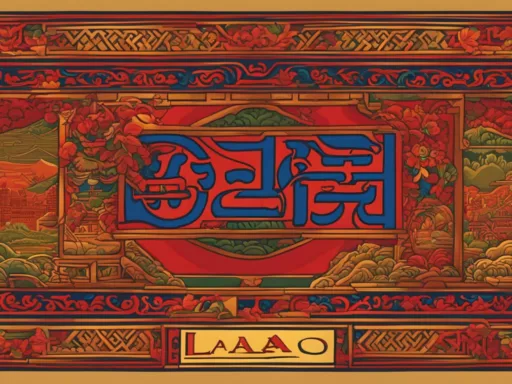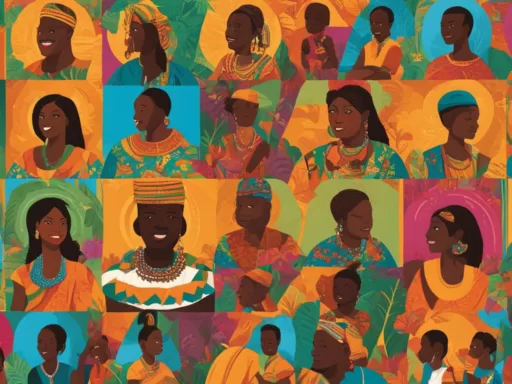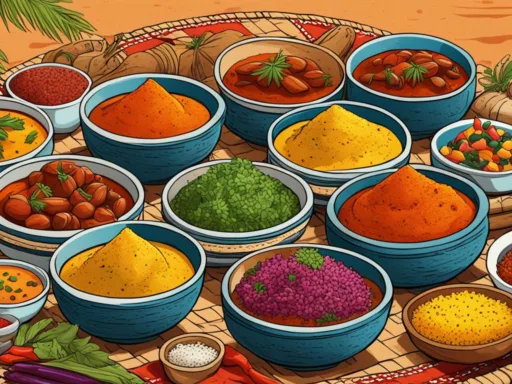Diving into the heart of Central America reveals a rich and varied linguistic landscape, and Honduras stands as a prime example of this diversity. While the official languages Honduras acknowledges is Spanish, known specifically as the Spanish language Honduras, a symphony of spoken words echoes throughout the nation, encompassing a variety of indigenous dialects and Creole influences. From the echoing sounds of Garifuna ceremonies to the hustle of Spanish-speaking markets in Tegucigalpa, the languages spoken Honduras are as much part of its identity as its verdant mountains and Caribbean coastline.
Key Takeaways
- Spanish is the official and most widely spoken language in Honduras, holding a significant place in daily communication and governmental affairs.
- Honduras’ rich linguistic repertoire includes various indigenous and Creole languages, such as Garifuna and Bay Islands English, reflecting the nation’s cultural blend.
- The preservation and celebration of minority languages like Lenca and Ch’orti’ highlight the importance of cultural heritage in Honduras.
- Honduran Sign Language provides an essential mode of communication for the hearing impaired, showcasing the inclusivity of the country’s language policies.
- Fostering language diversity has profound implications for maintaining the social fabric and historical consciousness of Honduras.
Unveiling Honduras’ Linguistic Landscape
As we traverse through the mosaic of cultures in Honduras, the harmonious blend of languages tells a story of history, identity, and resilience. The Spanish language Honduras holds as its official tongue, radiates through every layer of society. Yet, there is a profound respect and enduring effort to preserve the rich tapestry of indigenous languages Honduras possesses, as well as the innovative ways people communicate, such as Honduran Sign Language.

The Predominance of Spanish in Honduran Culture
In Honduras, Spanish is not merely a language but the cultural glue that binds the society together. With its nuanced dialects resonating closely with Central American Spanish, it carries the unique Honduran identity. One notable characteristic is the preference for ‘vos’ over the more commonly used ‘tú’ in other Spanish-speaking regions, signifying the distinctive personality of the Spanish language Honduras.
Honduran Sign Language: Communicating Beyond Words
The importance of language extends beyond the spoken word. In the realm of silence, the Honduran Sign Language serves as an essential bridge, fostering inclusion and understanding for the hearing impaired. It embodies the nation’s commitment to accessibility and acknowledges the significance of every citizen’s ability to communicate and connect.
Tribute to Indigenous Tongues: Keeping Heritage Alive
Amidst the prevalence of Spanish, the ancestral whispers of Honduras’ original voices continue to echo. Languages such as Garifuna and Miskito hold the stories of vast numbers of Hondurans – approximately 100,000 and 29,000, respectively. They, along with Sumo, Pech, and Jicaque, are not just languages but also symbols of the enduring spirit of indigenous languages Honduras. These tongues, vibrant and alive, encapsulate a heritage that the Honduran community is passionately dedicated to preserving for future generations.
The Rich Tapestry of Indigenous Languages of Honduras
Within the borders of Honduras, a myriad of indigenous tongues paint a vibrant cultural canvas that transcends time. The Garifuna language Honduras is known for, brings with it a melody of Arawakan roots blended with Carib and European lexicons, creating a unique linguistic identity that enriches the Garifuna communities stretching along the Caribbean coast.

The resilient Miskito language Honduras reverberates in the air, spoken by the Miskito people, an ethnic group that embodies both tradition and the spirit of Honduras’ indigenous ancestry. With approximately 29,000 speakers, this language upholds the past and ignites the future, serving as a cornerstone of Honduras’ linguistic diversity.
When discussing the rich assortment of indigenous languages Honduras prides itself on, we cannot overlook the Pech language, a tongue considered isolated due to its unique placement on the linguistic map. Though spoken by less than a thousand individuals, the Pech language is a significant element of the identity of its native speakers, holding within its syntax and vocabulary the deep-seated heritage and collective history of the Pech people.
The significance of these languages extends far beyond mere communication; they are vibrant carriers of culture, tradition, and the collective narratives that mold the Honduran social fabric. The interlacing of the Garifuna language Honduras, Miskito language Honduras, and Pech language Honduras signifies the ongoing dance of preservation and celebration that Hondurans engage in to keep their indigenous heritages alive and flourishing.
- Garifuna: A fusion of Arawakan, Carib, and European elements, spoken by an estimated 100,000 people.
- Miskito: Central to the identity of the Miskito ethnic group, disseminating the tales and traditions of approximately 29,000 Hondurans.
- Pech: Considered an isolated language, the Pech tongue offers a profound glimpse into the hearts of a community striving to retain its linguistic uniqueness.
As we amplify the stories behind these languages, we extend our appreciation and understanding of the intricate tapestry that is Honduras’ cultural and linguistic legacy.
| Language | Speakers | Cultural Significance |
|---|---|---|
| Garifuna | Approx. 100,000 | Conveys the hybrid history and resilience of Garifuna communities |
| Miskito | Approx. 29,000 | Essential to the identity and stories of the Miskito people |
| Pech | Less than 1,000 | Symbolic of the Pech people’s deep-rooted heritage and history |
Languages spoken Honduras: Beyond the Official Tongue
While many are familiar with the dominant Spanish tongue that pervades Honduras, a closer examination reveals a linguistic mosaic teeming with minority languages Honduras harbors within its borders. These languages serve as a testament to the country’s multicultural legacy, imprinted with ancestral narratives and cultural crossroads.
The Resilient Garifuna Language: A Mélange of Cultures
The Garifuna language is a vibrant expression of resilience and cultural blend. Its unique cadence and structure, derived from a tapestry of African, Amerindian, and European influences, resonates with approximately 100,000 individuals in Honduras. This language is more than a mere means of communication; it is the living heartbeat of the Garifuna community and an indelible part of the cultural identity of the nation.
Miskito, Pech, and Beyond: Languages Preserving Identities
The Miskito language encapsulates the legacy of Honduras’ indigenous people, with roots that trace back to the ancient landscapes of South America. Alongside Miskito, the Pech language represents one of the several indigenous voices that are vital to preserving the unique identities and traditions of their respective communities. With a modest number of speakers, these languages are beautiful echoes of the past that continue to mold Honduras’ cultural contours.
The Fate of Minority Languages: Tol, Ch’orti’, and Others
As a country with diverse languages, Honduras faces a critical point in preserving its linguistic heritage. The Tol language Honduras – also known as Tolupan –, along with the Ch’orti’ language Honduras and others such as Tawahka, confront the challenges of declining speaker numbers. This decline not only indicates the possible loss of distinct linguistic frameworks but also the cultural wisdom and practices uniquely encapsulated within these languages.

Considering the precarious plight of these tongues, initiatives aimed at revitalizing and promoting them are vital to ensuring that the rich heritage of Honduras is not left to the annals of history but is instead celebrated and handed down to future generations.
| Language | Number of Speakers | Cultural Significance |
|---|---|---|
| Garifuna | ~100,000 | A symbol of cultural fusion and communal identity |
| Miskito | ~29,000 | Reflects Honduras’ indigenous heritage and South American origins |
| Pech | Carries the distinct identity and traditions of the Pech people | |
| Tolupan (Tol) | At risk; a reminder of the nation’s need for preservation efforts | |
| Ch’orti’ | A Mayan language facing extinction; holds ancient cultural knowledge |
Engaging with these languages means not only embracing minority languages Honduras celebrates but also acknowledging their intrinsic value as cultural cornerstones. They weave a narrative that extends beyond simplicity of speech, venturing into the realms of wisdom passed down through generations and the community’s collective soul. It is an endeavor to capture the essence of a nation’s spirit through the preservation and revitalization of its most precious voices.
Bay Islands’ Linguistic Peculiarities
The vibrant history of the Bay Islands is not only palpable in its verdant landscapes and pristine shores but also in the unique lexicon of its inhabitants. Here, the Bay Island Creole English language Honduras is notable for its historical context and contemporary relevance. As a linguistic reflection of the islands’ multifaceted past, this Creole English variant embodies the cultural interactions and adaptations of centuries past.

Bay Islands English: A Window into the Colonial Past
The Bay Islands’ English captures the essence of an era when English and Irish buccaneers roamed the Caribbean waters, leaving their mark on the archipelago’s culture and language. The Bay Island Creole English language Honduras preserves the nuances and intricacies of those times, offering a living museum of the age of exploration and conquest, where linguistic elements from different continents merged and evolved on the high seas and these far-flung lands.
Creole Influence and Language Evolution in the Caribbean
The story of the Caribbean Creole languages is one of dynamism and resilience. In the context of Honduras and its enchanting Bay Islands, Creole languages exemplify the transformative power of language—how it adapts, survives, and thrives, shaping itself to the rhythm of cultural tides. Their enduring usage within island communities attests to the potency of language in embodying identity and collective history.
| Language Variant | Origins | Usage & Significance |
|---|---|---|
| Bay Island Creole English | English and Irish pirate influence | Widely used across the Bay Islands, symbolizing the area’s colonial heritage |
| Caribbean Creole Languages | A blend of African, Amerindian, and European languages | Integral to the cultural identities of Caribbean communities |
The Bay Island Creole English language Honduras and Caribbean Creole languages existing today are not static relics but instead are active participants in the ongoing narrative of the Bay Islands, contributing to the cultural richness that attracts visitors from around the world.
Conclusion
The linguistic heritage of Honduras is a vibrant tapestry interwoven with threads of history, culture, and resilience. The country’s robust palette of languages—from the dominant Spanish to the myriad of indigenous and Creole tongues—serves as a bastion of its cultural diversity. Hondurans possess a composite identity, reflected in every sentence spoken and every gesture conveyed through their rich linguistic expressions.
Language as a Reflection of Diversity and History
In every corner of the nation, from the bustling cities to the tranquil archipelago of the Bay Islands, linguistic diversity is celebrated as a core aspect of national identity. The Spanish language, an enduring legacy of colonial past, blends seamlessly with the voices of the Garifuna, Miskito, and myriad other indigenous languages. These languages do not merely serve as a mode of communication but stand as living museums—preserving a history that is both complex and enriching. Embracing this cultural diversity Honduras is known for invites us on a journey through time and shared experience.
The Prospect of Language Preservation in Honduras
The challenge of language preservation is ever-present, demanding concerted and continuous efforts to ensure these linguistic jewels do not fade into silence. Honduras’ commitment to sustaining and nurturing its linguistic manifold is evidenced in its enthusiastic promotion of both majority and minority languages. Whether it’s through education, cultural initiatives, or legislation, the chorus of voices advocating for the vitality of language preservation Honduras champions is a testament to the nation’s dedication. By safeguarding these precious forms of expression, we uphold the heart of the nation’s heritage for each generation to inherit and enrich.
FAQ
What is the official language of Honduras?
The official language of Honduras is Spanish, also referred to as Castilian Spanish or Honduran Spanish. It is the primary language used for government, business, education, and daily communication.
How many indigenous languages are spoken in Honduras?
Honduras is home to several indigenous languages, including Garifuna, Miskito, Pech, Ch’orti’, Tawahka, Tol, and Lenca. These languages are integral to the cultural heritage of the indigenous peoples of Honduras.
Are there any Creole languages spoken in Honduras?
Yes, the Bay Island Creole English is a Creole language spoken in the Bay Islands of Honduras. It has origins from English and African languages and reflects the historical influences of English-speaking Caribbean settlers and pirates.
What is the state of the indigenous languages in Honduras?
Many indigenous languages in Honduras, such as Garifuna and Miskito, remain vibrant and are widely used within their communities. However, languages like Tol and Ch’orti’ are endangered with declining numbers of speakers, making their preservation critical.
Is sign language recognized in Honduras?
Yes, Honduran Sign Language is recognized and used within the deaf community in Honduras. It facilitates communication for thousands of hearing-impaired individuals and is an important aspect of the country’s linguistic diversity.
What efforts are being made to preserve the languages of Honduras?
Various initiatives have been taken to preserve the indigenous and Creole languages of Honduras, including education programs in native languages, documentation efforts, and cultural promotion activities aimed at raising awareness about the importance of language preservation.
How does the Garifuna language reflect the history of Honduras?
The Garifuna language is a testament to the history of Honduras, representing a blend of African, Amerindian, and European elements. It originated from the intermixing of African slaves and Caribbean Amerindians and is an integral part of the Garifuna community’s cultural identity.
Can Bay Islands English be considered a language derived from Standard English?
Bay Islands Creole English is indeed derived from English, but it has evolved significantly with influences from African languages and other elements to form a distinct Creole variant. It is recognized as a separate linguistic entity with its own unique characteristics.
Does the Spanish language in Honduras contain influences from indigenous languages?
Yes, the Spanish language in Honduras, as well as surrounding Central American countries, has been influenced by indigenous languages. This can be seen in the vocabulary, which includes indigenous words, particularly for local flora, fauna, and cultural references.
What is the role of language in the cultural diversity of Honduras?
Language plays a pivotal role in the cultural diversity of Honduras, reflecting the country’s rich history and the unique identities of its peoples. Each language carries the traditions, stories, and values of its community, contributing to the vibrant and diverse cultural tapestry of the nation.






